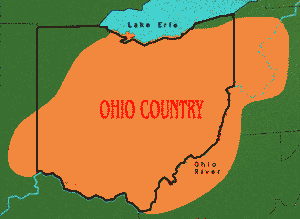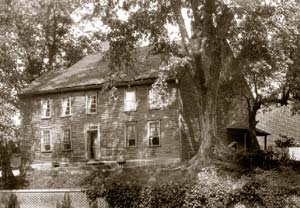Adventure Galley Flatboat
Before Ohio became a state, there were 1000s of people that wanted to come to what was then called the Ohio Country. Coming from the east, there were 2 options to reach this wilderness: travel on foot, or go by water. Many people did come on foot, but the trip was treacherous with no roads. The easier and somewhat safer way was on the water.

If you were like most of the new settlers, that meant reaching the Ohio River where it began in what is today Pittsburgh, and floating south. At some point the settlers would reach a place where they would put ashore, build a cabin, and plan their next move for the following year.
 One party of American pioneers coming to the Ohio Country departed from the towns of Ipswich, Massachusetts and Danvers, Massachusetts on December 3, 1787. They crossed the mountains until they reached Sumrill’s Ferry, near present-day West Newton, Pennsylvania on the Youghiogheny River.
One party of American pioneers coming to the Ohio Country departed from the towns of Ipswich, Massachusetts and Danvers, Massachusetts on December 3, 1787. They crossed the mountains until they reached Sumrill’s Ferry, near present-day West Newton, Pennsylvania on the Youghiogheny River.
During that bitterly cold winter, the men under the supervision of Rufus Putnam, built 2 flatboats: 1 was the 45 ton Adventure Galley also known as the Mayflower in honor of their Pilgrim ancestors, and a much smaller, 3 ton ‘Adelphia’. They also built 3 log canoes. The woodcut shown below depicts the construction of the Adventure Galley. The ship-builders first named the larger ship Adventure Galley. While it was not recorded why they chose that name, it should be noted that that was the name of a famous pirate boat from the 1600s. The ship was later re-named the Mayflower in honor of the famous vessel that bore the Puritan emigrants into Plymouth-- an earlier adventure into the new world.
 The Adventure Galley boat was 45' long and 12' wide, with curved bows, strongly timbered and covered with a decked roof, high enough for a man to walk upright under the beams.
The Adventure Galley boat was 45' long and 12' wide, with curved bows, strongly timbered and covered with a decked roof, high enough for a man to walk upright under the beams.
The sides were thick enough to resist the bullets of any Indians who might attack it, as they attacked and captured several boats later in the season.
This small fleet of boats carried the pioneers down the Youghiogheny River to the Monongahela River, and then to the Ohio River, and onward to the Ohio Country and the Northwest Territory. They arrived at their final destination, the mouth of the Muskingum River at the confluence of the Ohio and Muskingum rivers, on April 7, 1788.
Coming to Marietta
Marietta was the first permanent settlement in the Northwest Territory. There was another settlement called Martins Ferry that was set up a few years prior to this by squatters, but they were run out by troops sent from Pittsburgh. Abslom Martin is considered the first “legal” settler, arriving in 1787, but later moving on to Wheeling (Virginia) to marry. He brought his family back in 1791.
The boat first landed on the west side of the river near Fort Harmar (now site of Harmar Village or west Marietta). For Harmar had been built several years early as a trading and military post.
The banks of the Muskingum were thickly covered with large sycamore trees that had large sweeping branches stretching across the river, so much so that they hid the mouth of the Muskingum River.
The piloting the Adventure Galley had already passed the Muskingum before they realized that was the river they were seeking. Before they could correct their mistake they had floated too far to land on the upper point and were forced to land a short distance below the fort.
With the aid of ropes and some soldiers from the garrison at the fort, they pulled the heavy boat back up river to the Muskingum. That was on the 7th day of April, 1788, and ever since it is observed as the anniversary of the first settlement of Ohio.
Jervis Cutler, a boy of 16 and the son of Rev. Manassah Cutler, always claimed that he was the first person who leaped ashore when the boat landed; and was also the first to cut down a tree, which commenced the settlement of Ohio.
The weather in the valley had been so mild that the vegetation on landing was in striking contrast to the place of their embarkation, where snow still lngered in the hollows. The buffalo clover and other plants were already knee high and afforded a rich pasture for the hungry horses.
At the time of landing, Captain Pipe, a chief of the Delaware Indians, were then encamped on the headwaters of the Muskingum with about 70 others of his tribe received the strangers very graciously, shaking hands with them, saying they were welcome to the shore of the Muskingum. The settlers immediately started unloading boards for the erection of temporary huts and setting up Gen. Putnam's large marquee. Under the broad roof of this hempen house he resided and transacted the business of the colony for several months until the block-houses of Campus Martius, as their new garrison was called, was finished.
One of the early houses built within this stockade became the home of General Putnam. It is said that some of the framing timbers used in the construction of his house were from the dismantled Adventure Galley. The house stood next to the southeast blockhouse. Putnam made it his home until his death in 1828. It then became the property of Judge Arius Nye from whose daughter Minerva Tupper Nye it was purchased in 1919 by the State of Ohio.

Rufus Putnam's House Today
Located just off I-77 in downtown Marietta, along the Ohio River, this site tells Ohio's migration story. The museum is on the site of the first organized American settlement in the Northwest Territory. Founded by the Ohio Company of Associates in 1788, Campus Martius was a fort that served as a home for pioneers while they established Marietta.
The restored Rufus Putnam House, part of the original fort, is now enclosed within a wing of the Campus Martius Museum. Located just off I-77 in downtown Marietta, the museum is located on the site of Campus Martius. Behind the museum is the Ohio Company's Land Office, where some of the earliest maps of the Northwest Territory were created.


